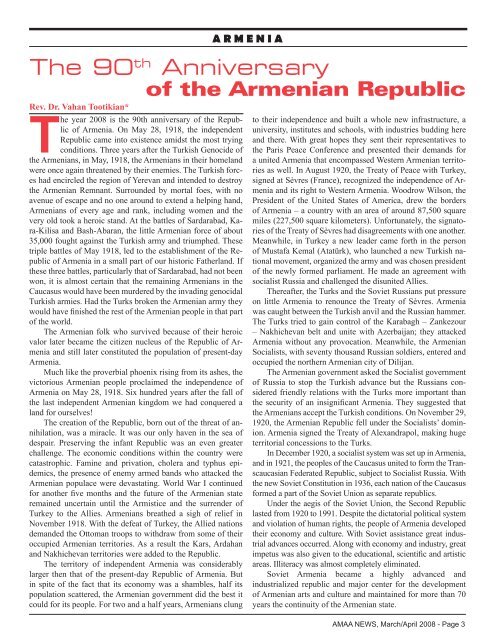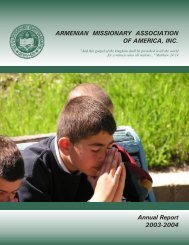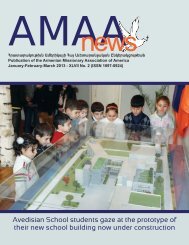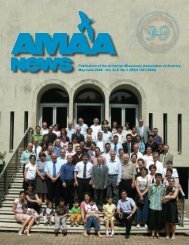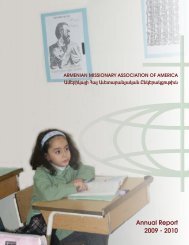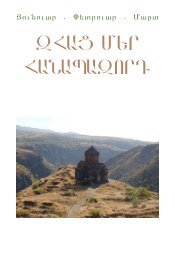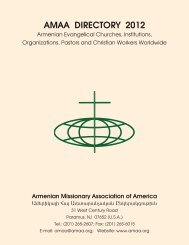Years - Armenian Missionary Association of America
Years - Armenian Missionary Association of America
Years - Armenian Missionary Association of America
You also want an ePaper? Increase the reach of your titles
YUMPU automatically turns print PDFs into web optimized ePapers that Google loves.
The 90th Anniversary<br />
<strong>of</strong> the <strong>Armenian</strong> Republic<br />
Rev. Dr. Vahan Tootikian*<br />
The year 2008 is the 90th anniversary <strong>of</strong> the Republic<br />
<strong>of</strong> Armenia. On May 28, 1918, the independent<br />
Republic came into existence amidst the most trying<br />
conditions. Three years after the Turkish Genocide <strong>of</strong><br />
the <strong>Armenian</strong>s, in May, 1918, the <strong>Armenian</strong>s in their homeland<br />
were once again threatened by their enemies. The Turkish forces<br />
had encircled the region <strong>of</strong> Yerevan and intended to destroy<br />
the <strong>Armenian</strong> Remnant. Surrounded by mortal foes, with no<br />
avenue <strong>of</strong> escape and no one around to extend a helping hand,<br />
<strong>Armenian</strong>s <strong>of</strong> every age and rank, including women and the<br />
very old took a heroic stand. At the battles <strong>of</strong> Sardarabad, Kara-Kilisa<br />
and Bash-Abaran, the little <strong>Armenian</strong> force <strong>of</strong> about<br />
35,000 fought against the Turkish army and triumphed. These<br />
triple battles <strong>of</strong> May 1918, led to the establishment <strong>of</strong> the Republic<br />
<strong>of</strong> Armenia in a small part <strong>of</strong> our historic Fatherland. If<br />
these three battles, particularly that <strong>of</strong> Sardarabad, had not been<br />
won, it is almost certain that the remaining <strong>Armenian</strong>s in the<br />
Caucasus would have been murdered by the invading genocidal<br />
Turkish armies. Had the Turks broken the <strong>Armenian</strong> army they<br />
would have finished the rest <strong>of</strong> the <strong>Armenian</strong> people in that part<br />
<strong>of</strong> the world.<br />
The <strong>Armenian</strong> folk who survived because <strong>of</strong> their heroic<br />
valor later became the citizen nucleus <strong>of</strong> the Republic <strong>of</strong> Armenia<br />
and still later constituted the population <strong>of</strong> present-day<br />
Armenia.<br />
Much like the proverbial phoenix rising from its ashes, the<br />
victorious <strong>Armenian</strong> people proclaimed the independence <strong>of</strong><br />
Armenia on May 28, 1918. Six hundred years after the fall <strong>of</strong><br />
the last independent <strong>Armenian</strong> kingdom we had conquered a<br />
land for ourselves!<br />
The creation <strong>of</strong> the Republic, born out <strong>of</strong> the threat <strong>of</strong> annihilation,<br />
was a miracle. It was our only haven in the sea <strong>of</strong><br />
despair. Preserving the infant Republic was an even greater<br />
challenge. The economic conditions within the country were<br />
catastrophic. Famine and privation, cholera and typhus epidemics,<br />
the presence <strong>of</strong> enemy armed bands who attacked the<br />
<strong>Armenian</strong> populace were devastating. World War I continued<br />
for another five months and the future <strong>of</strong> the <strong>Armenian</strong> state<br />
remained uncertain until the Armistice and the surrender <strong>of</strong><br />
Turkey to the Allies. <strong>Armenian</strong>s breathed a sigh <strong>of</strong> relief in<br />
November 1918. With the defeat <strong>of</strong> Turkey, the Allied nations<br />
demanded the Ottoman troops to withdraw from some <strong>of</strong> their<br />
occupied <strong>Armenian</strong> territories. As a result the Kars, Ardahan<br />
and Nakhichevan territories were added to the Republic.<br />
The territory <strong>of</strong> independent Armenia was considerably<br />
larger then that <strong>of</strong> the present-day Republic <strong>of</strong> Armenia. But<br />
in spite <strong>of</strong> the fact that its economy was a shambles, half its<br />
population scattered, the <strong>Armenian</strong> government did the best it<br />
could for its people. For two and a half years, <strong>Armenian</strong>s clung<br />
A R M E N I A<br />
to their independence and built a whole new infrastructure, a<br />
university, institutes and schools, with industries budding here<br />
and there. With great hopes they sent their representatives to<br />
the Paris Peace Conference and presented their demands for<br />
a united Armenia that encompassed Western <strong>Armenian</strong> territories<br />
as well. In August 1920, the Treaty <strong>of</strong> Peace with Turkey,<br />
signed at Sèvres (France), recognized the independence <strong>of</strong> Armenia<br />
and its right to Western Armenia. Woodrow Wilson, the<br />
President <strong>of</strong> the United States <strong>of</strong> <strong>America</strong>, drew the borders<br />
<strong>of</strong> Armenia – a country with an area <strong>of</strong> around 87,500 square<br />
miles (227,500 square kilometers). Unfortunately, the signatories<br />
<strong>of</strong> the Treaty <strong>of</strong> Sèvres had disagreements with one another.<br />
Meanwhile, in Turkey a new leader came forth in the person<br />
<strong>of</strong> Mustafa Kemal (Atatürk), who launched a new Turkish national<br />
movement, organized the army and was chosen president<br />
<strong>of</strong> the newly formed parliament. He made an agreement with<br />
socialist Russia and challenged the disunited Allies.<br />
Thereafter, the Turks and the Soviet Russians put pressure<br />
on little Armenia to renounce the Treaty <strong>of</strong> Sèvres. Armenia<br />
was caught between the Turkish anvil and the Russian hammer.<br />
The Turks tried to gain control <strong>of</strong> the Karabagh – Zankezour<br />
– Nakhichevan belt and unite with Azerbaijan; they attacked<br />
Armenia without any provocation. Meanwhile, the <strong>Armenian</strong><br />
Socialists, with seventy thousand Russian soldiers, entered and<br />
occupied the northern <strong>Armenian</strong> city <strong>of</strong> Dilijan.<br />
The <strong>Armenian</strong> government asked the Socialist government<br />
<strong>of</strong> Russia to stop the Turkish advance but the Russians considered<br />
friendly relations with the Turks more important than<br />
the security <strong>of</strong> an insignificant Armenia. They suggested that<br />
the <strong>Armenian</strong>s accept the Turkish conditions. On November 29,<br />
1920, the <strong>Armenian</strong> Republic fell under the Socialists’ dominion.<br />
Armenia signed the Treaty <strong>of</strong> Alexandrapol, making huge<br />
territorial concessions to the Turks.<br />
In December 1920, a socialist system was set up in Armenia,<br />
and in 1921, the peoples <strong>of</strong> the Caucasus united to form the Transcaucasian<br />
Federated Republic, subject to Socialist Russia. With<br />
the new Soviet Constitution in 1936, each nation <strong>of</strong> the Caucasus<br />
formed a part <strong>of</strong> the Soviet Union as separate republics.<br />
Under the aegis <strong>of</strong> the Soviet Union, the Second Republic<br />
lasted from 1920 to 1991. Despite the dictatorial political system<br />
and violation <strong>of</strong> human rights, the people <strong>of</strong> Armenia developed<br />
their economy and culture. With Soviet assistance great industrial<br />
advances occurred. Along with economy and industry, great<br />
impetus was also given to the educational, scientific and artistic<br />
areas. Illiteracy was almost completely eliminated.<br />
Soviet Armenia became a highly advanced and<br />
industrialized republic and major center for the development<br />
<strong>of</strong> <strong>Armenian</strong> arts and culture and maintained for more than 70<br />
years the continuity <strong>of</strong> the <strong>Armenian</strong> state.<br />
AMAA NEWS, March/April 2008 - Page 3


